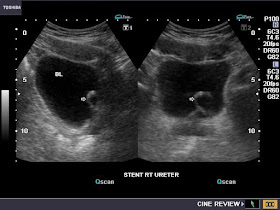3- D ultrasound image of ureterocele:
The Rt. ureterocele is seen as a small sac bulging in from the posterior wall of the bladder.

3-D ultrasound image of bladder diverticulum:
A small right sided vesical diverticulum. (UB= urinary bladder)

Vesical calculus:
This 3-D ultrasound image of a vesical calculus shows that 3-D imaging must be used in conjunction with 2-D B-mode imaging to identify pathology. This bladder calculus is difficult to distinguish from (see topmost image) ureterocele purely on 3-D ultrasound. Perhaps a cross sectional image would show the internal structure better. (All images courtesy of Ravi Kadasne, MD, UAE).
For more images of urinary bladder diseases/ conditions see:
http://www.ultrasound-images.com/urinary-bladder.htm

Other interesting applications of 3-D ultrasound imaging:
Benign prostatic hypertrophy- showing the enlarged median lobe

A musculoskeletal 3- D ultrasound image- Baker cyst in Right popliteal fossa:























